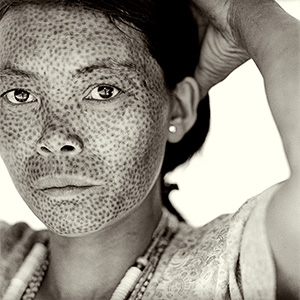
My latest story in Nikkei Asia is about the face tattoos of Chin women in Myanmar, documented by German photographer Jens Uwe Parkitny for the past 15 years. The traditional practice of face tattoos is often misunderstood by Western observers who regard them as ugly.
BANGKOK — The woman’s eyes are closed. She looks content, perhaps there is a hint of a smile playing around her lips. There is a blue circle with a cross in its center on her forehead from which strong dark lines emanate across her entire face, including her eyelids, like a rising sun.
This is a strong face, a face filled with identity, pride and beauty. She is Chin, an ethnic minority living in northwestern Myanmar, and she is one of the last women of her culture to have her face tattooed.
“I shot the first portrait of a Chin woman with a facial tattoo in 2001,” recounted German photographer Jens Uwe Parkitny, whose exhibition of Chin face tattoo portraits is now on show at the Foreign Correspondents’ Club of Thailand in Bangkok.
“I showed it to a few people and they liked it. I am a self-taught photographer, and back then I was heavily influenced by the National Geographic photography school because I was a travel journalist. But I realized, I didn’t want to tell the story that way. I wanted to tell a more personal story of dignity and beauty. A different type of beauty, but still beauty, and getting to that point, that turned into a long journey,” he explained.
According to the United Nations, minorities make up 10% to 20% of the global population, between 600 million and 1.2 billion people. The unique identities of indigenous groups in the Americas, Africa, Asia and Australia encompass ethnic, linguistic and religious aspects. Tattooing in general and face tattoos in particular have been an integral part of traditional societies for centuries, for both men and women, to denote identity, belonging, courage, coming of age and beauty.
While a few minorities, including the Maori in New Zealand, some Native Americans and the Inuit, have hung on to or revived their tattoo traditions, many more have been lost in the maelstrom of 20th-century progress and development, suppressed by nationalist projects, and majority rule and its accompanying policies of assimilation. As a consequence, indigenous tattoos often changed from integral markers of common identity to signifiers of shame and backwardness.…

Read the full story here.

